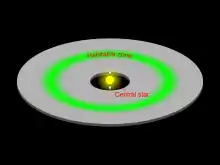Alderson disk
An Alderson disk[1][2] (named after Dan Alderson, its originator) is a hypothetical artificial astronomical megastructure, like Larry Niven's Ringworld and the Dyson sphere. The disk is a giant platter with a thickness of several thousand miles. The Sun rests in the hole at the center of the disk. The outer perimeter of an Alderson disk would be roughly equivalent to the orbit of Mars or Jupiter. According to the proposal, a sufficiently large disk would have a larger mass than its Sun.

The hole would be surrounded by a thousand-mile-high wall to prevent the atmosphere from drifting into the Sun. The outer rim would take care of itself.
The mechanical stresses within the disc would be far beyond what any known material can stand, thus relegating such a structure to the realm of exploratory engineering until materials and construction science become sufficiently advanced. Building a megastructure of this magnitude would require an amount of material that far surpasses the amount of material found in the Solar System.
Life could exist on either side of the disk, though close to the Sun the heat would make life impossible without protection. Conversely, farther away from the Sun living beings would freeze. Therefore, for the entirety of such a structure to be made habitable, it would have to include a vast number of life support systems. Even without such systems the habitable surface area would be an equivalent of tens to hundreds of millions of Earths.
Because the Sun remains stationary, there is no day/night cycle, only a perpetual twilight. This could be solved by forcing the Sun to bob up and down within the disk, lighting first one side then the other.[3]
In popular culture
In 1974, the science fiction writer Larry Niven suggested that an Alderson disk "would be a wonderful place to stage a Gothic or swords-and-sorcery novel. The atmosphere is right, and there are real monsters." Because the zone habitable by humans is relatively narrow, the disc (and the cost of its construction) could be shared with aliens from hotter and colder planets. Over long periods of time, lifeforms would evolve to settle the sparsely-inhabited regions in between. "If civilization should fall, things could get eerie and interesting."[3]
An Alderson disk (the Godwheel) was a prominent feature of Malibu Comics' Ultraverse. The Godwheel was split between two societies, one which used technology and one which used magic (each occupied its own side of the disk). Larry Niven designed the Godwheel, and wrote stories surrounding certain events on it.
Rak Mesba is a partial ancient alien Alderson Disk in Orion's Arm, a multi-authored online science fiction world-building project.[4]
A disk-shaped planet similar to an Alderson disk (though far smaller) served as the home world of the fantasy "Aysle" setting (or "cosm") of West End Games' Torg roleplaying game. In contrast with the Alderson disk, the Aysle "diskworld" works according to fantasy physics, including a "gravity plane" that bisects the disk laterally, so that opposite sides "fall" towards the plane. The diskworld of Aysle had a bobbing Sun and multiple inner layers. Both sides of the disk were inhabited, as were the internal layers.
In Charles Stross's Missile Gap, a copy of the whole Earth (along with copies of many other planets) is placed on an Alderson disk built around a black hole by unknown forces.
Ian McDonald's novel Empress of the Sun features a parallel-universe version of our solar system where creatures evolved from dinosaurs have converted all the mass to an Alderson disk (with a bobbing sun).
In Terry Pratchett's science fiction novel Strata the concept of a Alderson disk is brought up by the protagonist, Kin Arad, as an explanation for the mysterious 'flat earth' that is the focus of the story.
See also
- Dyson sphere – Hypothetical megastructure around a star
- Dyson spheres in popular culture – Dyson spheres depicted in popular culture
- Dyson tree – Hypothetical genetically-engineered plant capable of growing inside a comet
- Globus Cassus – Art project and book by Swiss architect and artist Christian Waldvogel
- Kardashev scale – Method of measuring a civilization's level of technological advancement
- Klemperer rosette – Type of gravitational system
- Matrioshka brain – hypothetical megastructure of immense computational capacity
- Megascale engineering
- Planetary engineering – application of technology for the purpose of influencing the global environments of a planet
- Ringworld – 1970 science fiction novel by Larry Niven
- Star lifting
- Stellar engineering – Hypothetical artificial modification of stars
- Tensegrity – Structural principle based on the use of isolated components in compression inside a net of continuous tension
- Terraforming – Hypothetical planetary engineering process
- Tabby's Star – Star noted for unusual dimming events
References
- Hadhazy, Adam (5 August 2014). "Could We Build a Disk Bigger Than a Star?". Popular Mechanics.
- Wegert, David (1 February 2014). Spirit Guides from the Future. Author House. ISBN 9781491850145 – via Google Books.
- Niven, Larry (1974). "Bigger Than Worlds". A Hole in Space. New York: Ballantine Books. pp. 123–124. ASIN B002B1MS6U. This essay was first published in Analog magazine (1974), and is also anthologised in Playgrounds of the Mind.
- "Rak Mesba". Orion's Arm - Encyclopedia Galactica. Retrieved 2019-06-20.
External links
- Hadhazy, Adam (5 August 2014). "Could We Build a Disk Bigger Than a Star?". Popular Mechanics. Retrieved 23 December 2016.
- Fictional Alderson Disk Rak Mesba
- Diskworlds